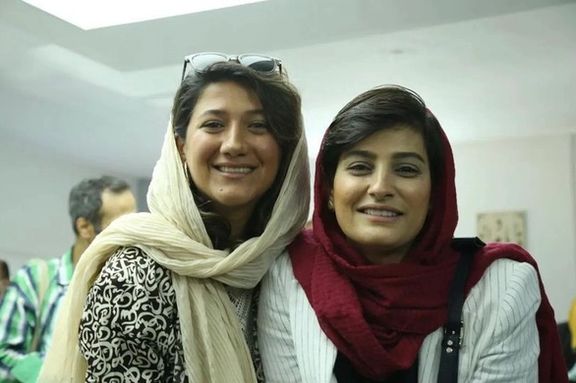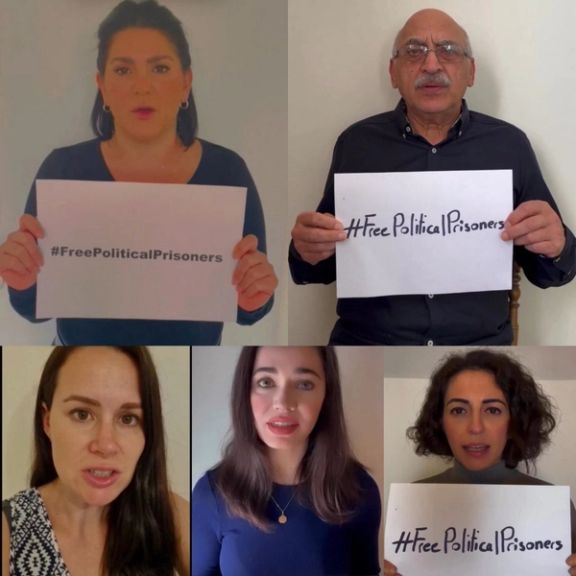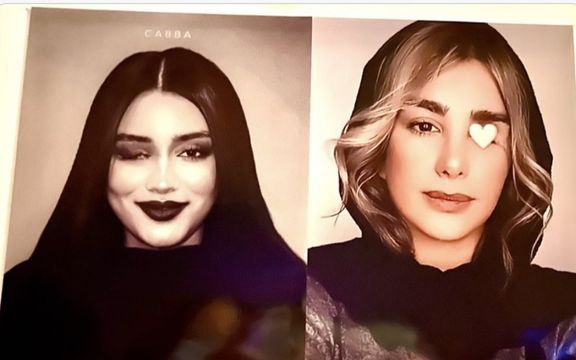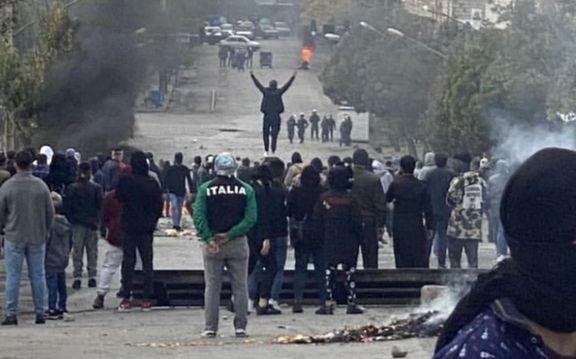Two Dozen Iranian Journalists Still Behind Bars

Iranian Journalists Association has published a new list of two dozen journalists who are still in detention after widespread arrets during antigovernment protests.

Iranian Journalists Association has published a new list of two dozen journalists who are still in detention after widespread arrets during antigovernment protests.
The Committee to Follow up on Situation of Arrested Journalists has prepared a list of these people saying at least 24 journalists are still under arrest.
Based on official and unofficial reports, the association says almost 100 journalists have been arrested or summoned since the beginning of anti-regime protests in mid-September, and some of them released on bail.
Elaheh Mohammadi and Niloufar Hamedi, who published the news about the death of Mahsa Amini in police custody for the first time, are among the ones behind bars.
The committee also noted that it will soon publish a separate list of the names of journalists who have been temporarily released on bail.
Meanwhile, the reformist Ham-Mihan daily in a report on Wednesday said large bails are set for the temporary release of the detained protesters.
According to this report, the bail set for journalists was usually between 30 to 40 thousand US dollars, an astronomical sum for most Iranians.
In the past weeks, a number of detained journalists received heavy jail sentences, including Ehsan Pirbornash, who was sentenced to 18 years in prison.
In its 43-year history, the Islamic Republic has arrested hundreds of journalists, and many have been killed inside and outside prisons. The regime keeps tight control over all print media and has a monopoly over radio and television. It also tightly censors Internet content by blocking thousands of websites and major social media platforms.

Several former foreigners and dual citizens held hostage in Iran as well as their families have launched an online campaign to demand release of Iranian political prisoners.
Several former foreigners and dual citizens held hostage in Iran as well as their families have launched an online campaign to demand release of Iranian political prisoners.
British-Iranian businessman Anoosheh Ashoori and his daughter Elika, Kylie Moore-Gilbert, an Australian academic previously jailed in Iran for over two years, Ghazal Sharmand, the daughter of German-Iranian journalist and software engineer Jamshid Sharmahd – facing execution in Iran, and the daughter of Nahid Taghavi, another German-Iranian rights activist sentenced to 10 years in Iran since October 2020 are among the most prominent figures in the campaign.
Sharmand’s daughter said the campaign is aimed at showing the world “that the Islamic Regime’s terror extends outside of Iran’s borders, and no one is safe until we all stand up.”
Ashoori’s daughter said in a tweet that “The Islamic Republic continues its cruel practice of hostage taking, rape, torture and murder to rule by fear.”
“We’re merely a handful of families affected by this barbarity. We come together to raise awareness on the issue and appeal to the public to stand up against this regime,” she added.
Earlier in the week, Siamak Namazi, who has been kept in jail since October 2015 on trumped-up espionage charges, finished a one-week hunger strike. He released a statement saying that the seven-day hunger strike has left his body a bit weaker, but also, thanks to strong support, his spirit is greatly invigorated.

Australia has expressed deep concern over Iran’s "interference" in the country's affairs, including "in person and online harassment" of Australian citizens.
A spokeswoman for Foreign Minister Penny Wong told the ABC, “The Australian government is deeply concerned by reports of foreign interference, including the harassment and intimidation of Australians online and in-person".
"We have raised our concerns about foreign interference directly to the Iranian regime in no uncertain terms," said the spokesperson who did not want to reveal her identity.
"Australia will continue to work domestically to keep Australians safe from foreign interference and with our like-minded partners to apply pressure on the Iranian regime over its egregious human rights abuses."
She also noted that Australia has been integral to building pressure internationally and was at the forefront of efforts to remove Iran from the Commission for the Status of Women.
Based on a report tabled in parliament, ABC reported that Iranian Revolutionary Guard-affiliated elements have launched targeted cyber-attacks on Australian organizations, with the aim of using the data obtained for extortion.
“The IRGC-affiliated actors are actively targeting a broad range of entities, including entities across multiple US critical infrastructure sectors as well as Australian, Canadian, and United Kingdom organizations,” the report says.
The report suggests IRGC agents often operate under the auspices of Najee Technology Hooshmand Fater LLC, based in Karaj, Iran, and Afkar System Yazd Company, based in Yazd, Iran.

Several young Iranians who lost one or both eyes after security forces fired pellets at their faces, say they do not regret having protested against the regime.
“I don’t feel miserable because of what happened. I lost some things but gained many others,” Kowsar (Mahbanou) Khoshnoudi-Kia, a young athlete who was shot in the left eye during an anti-government protest in Kermanshah in western Iran on December 9 said in a video post.
Khoshoudi-Kia, a member of the Iranian women’s archery national team and the runner-up of the Asian Archery Championships in 2021, said despite several operations in the past two months doctors have not been able to restore her eyesight.
The incident happened while Khoshnoudi-Nia and her father participated in a “silent march”. “The anti-riot police shot at us, and we were both wounded. Two pellets hit my father’s left arm. I was hit with three in the left arm and one in the left eye,” she said in the video.
Security forces in Iran use a shotgun shell known as ‘bird shot’ with small metal pellets that is less likely to kill from a distance but can indiscriminately blind people in a crowd. Some protesters who were shot at close range died from the birdshots.
Farideh Salavatipour, another victim who was shot in Sanandaj in west Iran on November 17 has lost both eyes and there is no hope to restore her eyesight. A photo of her showing her injuries with blood trickling down from one of her eyes down her face dotted with at least eighteen birdshots was published on social media because she said she did not want to remain anonymous and be forgotten.
On December 14, the head of the accident and emergency ward of Sina Hospital in Tehran, Hossein Kermanpour, told Ham Mihan newspaper that eye injuries were at the top of all injuries sustained by protesters who were shot with pellets and birdshots.
Kermanpour added that security forces who are not properly trained cause the high number of serious injuries because they shot the victims from close distances. He also pointed out that in some instances the shooting caused injuries in the lungs and in the genital area.

Some of the victims have, however, claimed that they were purposely shot in the face or in the genital area. “Why did you shoot me? Why were you smiling when you did?” Ghazal Ranjkesh who has lost one of her eyes asked her assailant in an Instagram post. A photo she has shared of her face shows injuries from tens of birdshots. Ranjkesh was shot during a protest in Bandar Abbas in southern Iran.
According to Kermanpour, some of the victims fearing arrest if they’d sought treatment in hospitals, sometimes only did so several days after the injury and when infection had set in.
The number of protesters who were wounded in the eye during the recent protests is not known but is estimated to amount to hundreds of cases.
A group of ophthalmology professors and doctors in November warned about the high number of eye injuries caused by pellets, birdshots and paintball guns during the protests that started four months ago, and said in many cases the injuries had led to the loss of one or both eyes.
During protests in November 2021 in Esfahan in central Iran tens of protesters were also shot in the eyes. A medical official told Iranian state television at the time that 40 people had been treated for eye injuries sustained during the protests, with 19 hospitalized. An injured eye became a social-media symbol for the suppression of the protests, with many activists posting images of bloody eyes or people holding bandage to an eye

Iran’s Foreign Minister Hossein Amir-Abdollahian has said that the United States is in no position to even speak about human rights.
In a tweet on Tuesday, Amir-Abdollahian said as a result of Washington’s “interventionism” two million people have been “slaughtered” in Iraq, Afghanistan, Yemen and Syria, and the United States is also “enflaming the fire of the Ukrainian war”.
“Stop hypocrisy. The great nation of Iran knows well the malevolence behind nice-sounding words,” he added.
His comments come after US State Department Spokesman Ned Price said Monday that the US is united with its allies and partners in the need to confront Iran’s leadership for its human rights abuses and destabilizing activities.
Islamic Republic’s foreign minister claimed that the White House still insists to hold direct negotiations with Iran. “If there is a serious will on the other side, we believe an agreement would be attainable,” he said at a meeting at the foreign ministry.
Referring to anti-government protests, Amir-Abdollahian said Monday that the Americans realized earlier than the three European countries that nothing special has happened and will not happen in Iran.
The United States has openly stated that its “focus” now is on “the remarkable bravery and courage that the Iranian people are exhibiting through their peaceful demonstrations”, and the EU has come up with new sanctions on Tehran.
The unrest in Iran after the death of Mahsa Amini have garnered strong sympathy around the globe. At the same time Iran’s unwillingness to compromise on the nuclear issue persuaded the US to adopt a tougher position toward Tehran.

Official data show a surge of about 5,000 deaths in the Iranian month of Aban, which corresponds with days the regime intensified its crackdown on nationwide protests.
Iranian Journalist Amir-Hadi Anvari cited the data released by Iran’s National Organization for Civil Registration that shows the number of deaths registered in the country from October 23 to November 21 was around 5,000 more than in the previous month.
This can be an indication that security forces killed many more people than what human rights groups estimated, that total 500 civilian casualties in four months. Moreover the October-November period was when the regime used more deadly violence against protesters, compared with the previous month of Mehr and the following month of Azar.
According to official numbers in the civil registry, the total number of deaths recorded in the month of Aban that ended at the peak of the ongoing protests in the country was 37,488, while this number was 32,455 in the previous Iranian month and 35,564 in the month before.
In 2021, the month of Aban had fewer deaths than the preceding 30-day period, which makes the jump in 2022 more strange.
The number of deaths categorized by provinces indicates that the two provinces of Sistan-Baluchistan and Kordestan had the highest increase in the number of deaths in the mentioned timespan. The regime has confirmed that the Revolutionary Guard’s Ground Forces have been deployed to Kurdish areas to crack down on protesters, and numbers published by human rights organization also show that the highest number of protesters killed were in these two regions.
The crackdown in the Sunni majority province of Sistan-Baluchestan was especially harsh during the month of Aban. The crackdown on protesters in Zahedan, the provincial capital of Sistan-Baluchestan, known as Bloody Friday, occurred September 30, when security forces killed more than 80 people, including women and children. Sistan-Baluchestan is the country’s second largest but least developed province, and the Baluch Sunni minority is among the most persecuted in Iran.
The current wave of antigovernment protests started across the country in mid-September, following the death in custody of 22-year-old Mahsa Amini, and the regime’s crackdown got deadlier as the rallies continued.
The US-based Human Rights Activists News Agency (HRANA), one of the groups that monitors and publishes daily statistics about the protests, said Tuesday that 525 protesters have been killed from September 17 to January 23, including 71 children. The number of the arrested protesters is nearly 20,000 while the regime has so far executed four people and dozens are sentenced to ‘moharebeh’ -- meaning “fighting God” in the lexicon of the Iranian regime -- and ‘corruption on earth’ that carry the death penalty. The Islamic Republic applies the charge based on vague Islamic-Arabic terms to people who might get into a confrontation with security forces during protests.
Many people have speculated that the number of the deaths in the crackdown is way higher, but the families of the victims are threatened not to talk to the media and bury their loved ones without large funeral services or mourning ceremonies.
Although there is no possibility at this point to scientifically study the trend in the number of deaths and address all possible explanations, the 5,000 jump in one month is a cause of concern that needs further in-depth analysis.

In November 2019, a series of protests in Iran, sometimes known as Bloody November, took place throughout the country. Initially triggered by a 50 to 200-percent increase in fuel prices, the demonstrations quickly turned into calls for the overthrow of the government and Supreme Leader Ali Khamenei. According to a report by a rights group, at least 3,000 protesters were killed by the Islamic Republic security forces from November 15 to 17, and nearly 20,000 arrested. Reuters at the time reported 1,500 deaths, while the official figure announced by the regime is about 300.
In March 2022, the annual number of deaths in Iran since Covid-19 began was also reported to be 300,000 higher than previous years. The official figure that the Islamic Republic has reported is 145,000 deaths from Covid since the beginning of the pandemic, the Middle East’s highest official level - leaving 160,000 more deaths unexplained.
The data from Iran’s national organization for civil registration had put the average number of deaths at 370,000 per year for four years up to March 20, 2020, when the pandemic began. In the first year (ending March 20, 2021) deaths rose to 510,000 and in the second year to 530,000.